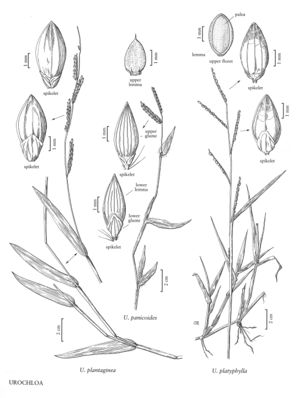Difference between revisions of "Urochloa plantaginea"
FNA>Volume Importer |
FNA>Volume Importer |
||
| Line 20: | Line 20: | ||
-->{{Treatment/Body | -->{{Treatment/Body | ||
|distribution=Puerto Rico;Md.;N.J.;Miss.;Tex.;La.;Pa.;Ala.;Ark.;Pacific Islands (Hawaii);Ga.;S.C.;Fla. | |distribution=Puerto Rico;Md.;N.J.;Miss.;Tex.;La.;Pa.;Ala.;Ark.;Pacific Islands (Hawaii);Ga.;S.C.;Fla. | ||
| − | |discussion=<p | + | |discussion=<p>Urochloa plantaginea, native to western and central Africa, is found from the southeastern United States to Argentina. It is now established in the southeastern United States, growing in loose sand and loam soils. Although considered a weed in the Flora area, Sendulsky (1978) stated that it provided good forage.</p><!-- |
| − | --><p>Hall (1978) reported | + | --><p>Hall (1978) reported Urochloa oligobrachiata (Pilg.) Kartesz [as Brachiaria platytaenia Stapf] from Florida. This report was based on one collection, but the voucher specimen has not been verified. It is similar to U. plantaginea, but it differs in having acute to acuminate lower glumes and shortly awned upper lemmas. It is native to western Africa.</p> |
|tables= | |tables= | ||
|references= | |references= | ||
| Line 37: | Line 37: | ||
|basionyms= | |basionyms= | ||
|family=Poaceae | |family=Poaceae | ||
| + | |illustrator=Linda A. Vorobik and Cindy Roché | ||
|distribution=Puerto Rico;Md.;N.J.;Miss.;Tex.;La.;Pa.;Ala.;Ark.;Pacific Islands (Hawaii);Ga.;S.C.;Fla. | |distribution=Puerto Rico;Md.;N.J.;Miss.;Tex.;La.;Pa.;Ala.;Ark.;Pacific Islands (Hawaii);Ga.;S.C.;Fla. | ||
|reference=None | |reference=None | ||
| Line 42: | Line 43: | ||
|publication year= | |publication year= | ||
|special status= | |special status= | ||
| − | |source xml=https:// | + | |source xml=https://bibilujan@bitbucket.org/aafc-mbb/fna-data-curation.git/src/314eb390f968962f596ae85f506b4b3db8683b1b/coarse_grained_fna_xml/V25/V25_1328.xml |
|subfamily=Poaceae subfam. Panicoideae | |subfamily=Poaceae subfam. Panicoideae | ||
|tribe=Poaceae tribe Paniceae | |tribe=Poaceae tribe Paniceae | ||
Revision as of 17:15, 30 October 2019
Plants annual. Culms 20-100 cm, decumbent, geniculate, branching and rooting at the lower nodes; nodes glabrous. Sheaths mostly glabrous, except the margins ciliate, with papillose-based hairs; ligules 0.5-1.5 mm; blades 3-21 cm long, 6-20 mm wide, glabrous, bases subcordate to cordate, clasping the stems, margins sometimes ciliate basally. Panicles 6-25 cm long, 2-7 cm wide, with 3-8 spikelike primary branches in 2 ranks; primary branches 2-11 cm, axes 1-1.5 mm wide, flat, margins scabrous; secondary branches absent; pedicels shorter than the spikelets, glabrous or scabrous. Spikelets (4)4.5-6 mm long, 1.9-2.2 mm wide, solitary, appressed to the branch axes, in 2 rows. Glumes separated by an internode of about 0.5 mm; lower glumes 1.5-2.5 mm, to 1/3 as long as the spikelets, broadly ovate, glabrous, 9-11-veined; upper glumes 3-4.2 mm, glabrous, 7(-9)-veined, without evident cross venation; lower florets sterile; lower lemmas 3-4.2 mm, glabrous, 5-veined; lower paleas present; upper lemmas 2.7-3.6 mm long, 1.5-2 mm wide, apices rounded; anthers 0.7-1 mm. Caryopses 2-2.5 mm. 2n = 36, 72.
Distribution
Puerto Rico, Md., N.J., Miss., Tex., La., Pa., Ala., Ark., Pacific Islands (Hawaii), Ga., S.C., Fla.
Discussion
Urochloa plantaginea, native to western and central Africa, is found from the southeastern United States to Argentina. It is now established in the southeastern United States, growing in loose sand and loam soils. Although considered a weed in the Flora area, Sendulsky (1978) stated that it provided good forage.
Hall (1978) reported Urochloa oligobrachiata (Pilg.) Kartesz [as Brachiaria platytaenia Stapf] from Florida. This report was based on one collection, but the voucher specimen has not been verified. It is similar to U. plantaginea, but it differs in having acute to acuminate lower glumes and shortly awned upper lemmas. It is native to western Africa.
Selected References
None.
